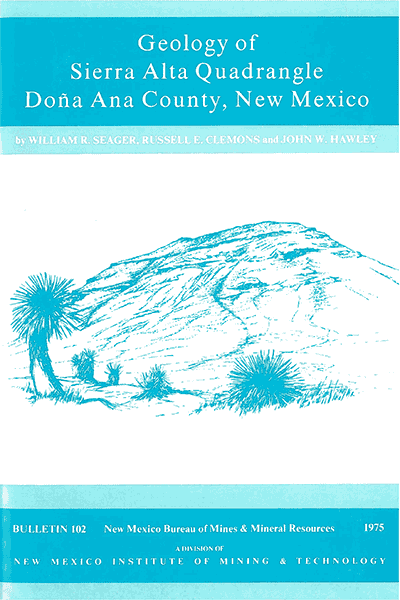
Bulletin 102—Geology of Sierra Alta Quadrangle, Doña Ana County, New Mexico
By W. R. Seager, R. E. Clemons, and J. W. Hawley, 1975, 56 pp., 2 tables, 13 figs., 2 appendices, 1 index, 1 sheet.

Describes stratigraphy of Permian to Holocene rocks. Structure includes a volcanotectonic depression which appears to be a precursor to Rio Grande rift in this area. Miocene to Pliocene faults superimpose across the depression. Also characterizes Quaternary evolution of landscape. This report covers the U.S. Geological Survey Sierra Alta 7½-min quadrangle. The area is located 3 mi southeast of Hatch and about 25 mi northwest of Las Cruces in northern Doña Ana County. US-85 crosses the northeastern corner of the quadrangle; other access is limited to a few ranch roads and jeep trails. The only permanent residents in the quadrangle live along the Rio Grande flood plain.
Mesas, buttes, cuestas, and deeply incised superimposed canyons are characteristic of the Sierra de Las Uvas-Cedar Hills uplands in the western part of the quadrangle. Benches, ridges, broad piedmont-slope remnants, terraces, and fans form the interfluves between major arroyo channels east of the mountains, and terminate in low bluffs flanking the Rio Grande valley floor. Badlands occur in many steep valley-slope terranes. Elevations range from 5,823 ft on Sierra Alta to about 4,000 ft on the flood plain of the Rio Grande; however, local relief seldom exceeds 1,000 ft.
Rocks exposed in the Sierra Alta quadrangle range in age from Permian to Holocene. Permian Hueco Limestone and Abo Sandstone, deformed during the Laramide, are unconformably overlain by a tripartite sequence of less deformed Tertiary volcanic and volcaniclastic strata. Basal andesitic epiclastic rocks are referred to as the Palm Park Formation. Middle rhyolitic ash-flow tuffs and epiclastic strata of the Bell Top Formation partly fill the Goodsight-Cedar Hills volcano-tectonic depression; numerous vent structures form the eastern margin of the depression. The upper Uvas Basaltic Andesite consists of a shield-like accumulation of flows centered on the axis of the depression. The Sierra de Las Uvas dome and the Sierro Kemado sag probably resulted from resurgent uplift of the central part of the volcanic pile following eruption of the basaltic andesite.
The volcano-tectonic depression appears to be a precursor to Rio Grande rift structure in this area. Miocene to Pliocene faults superimposed across the depression are, in part: 1) reactivated subsidence fractures, 2) new, throughgoing faults, and 3) fractures whose pattern is governed by the geometry of the Sierra de Las Uvas dome and its adjoining synclines. Bolson deposits of the lower Santa Fe Group fill Miocene basins.
Fluvial and piedmont-slope deposits of the Camp Rice Formation represent latest stages in the aggradation of late Tertiary fault basins. Middle to late Quaternary evolution of the present landscape was characterized by three major episodes of clayey incision by the Rio Grande and its tributaries. Each episode was followed by intervals of partial backfilling and subsequent periods of stability of valley base levels.
$7.00
Buy
Now
Also available as a free download.
Download
| File Name | Size | Last Modified |
|---|---|---|
| B102.pdf | 12.30 MB | 01/15/2021 10:56:27 AM |
| GISdata: | ||
| GeMSVariationReadMe.txt | 1 KB | 08/21/2020 09:49:52 AM |
| GDB: | ||
| SierraAltaBulletin102.gdb.zip | 26.97 MB | 08/21/2020 10:21:32 AM |
| MapPackage: | ||
| SierraAltaBulletin102.mpk | 30.25 MB | 08/18/2020 03:28:21 PM |
| Map: | ||
| Bulletin102_SierraAltaGeoPDF.pdf | 8.08 MB | 01/15/2021 11:00:18 AM |



